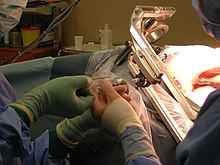Stereotactic brain surgery
Stereotactic brain operations (to Greek στερεός stereós "hard, rigid" and τάξις táxis "arrangement, facility") denotes minimally invasive procedures in neurosurgery and radiation therapy , in which the patient's head and medical instruments are fixed in a firmly screwed frame to achieve highest accuracy. Today's stereotactic interventions also often use real-time imaging by means of computed tomography and magnetic resonance imaging as well as computer-aided instrument guidance.
The image-controlled, computer-assisted calculation of paths and distances allows the experienced doctor to move around the inside of the body with almost no injury. Deep-lying foci of the disease can be identified with the greatest possible precision. Activation patterns can be classified using stereo electroencephalography . Cell samples can be taken by puncturing . Cancer growths in the brain and other vascular malformations can be eliminated (oncological stereotaxic). Movement disorders such as tremor , Tourette's syndrome or symptoms of Parkinson's disease and some forms of chronic pain can also be treated (functional stereotaxic).
In addition to therapeutic interventions on the brain, other extracranial (i.e. outside the head area) applications have developed, particularly in the field of ENT surgery.
Neurosurgery
The stereotactic surgery ( Stereoencephalotomie ) is a neuro-surgical operation where the structure is not to be operated on surgically exposed. Instead, the site of intervention is calculated using geometric methods. Functional brain surgery hoped that the introduction of this surgical method would provide a way of influencing cerebral functional processes, in contrast to classic neurosurgery, which essentially removes diseased tissue such as tumors , abscesses or vascular malformations.
Functional neurosurgery requires a method with which one can damage or even stimulate a point somewhere in the brain without creating lesions through the access . After the location of the intervention has been calculated, the stereotactic apparatus is attached to the skull and trephination is carried out to introduce a coagulation electrode. The operation is not painful and is therefore almost always performed under local anesthesia . The "functional stereotaxic" primarily uses the method of high-frequency deep brain stimulation after the implantation of suitable stimulation systems (colloquially brain pacemaker). For special indications , brain surgery, lesional procedures are also used directly .
For the first time, in the last years of the 19th century ( Rickman Godlee 1895), isolated operations were carried out on the exposed brain by means of a procedure called stereotaxic, which was already then known. The patient's body, and especially the head, was rigidly clamped into a reliably and strictly fixed frame system for the intervention. The tests of the possibilities carried out in the context of curiosity for research and psychiatric surgery were then still very limited and simple. In later decades the tools and methodology were refined. A three-dimensional ring system (“stereotactic frame”), stretched around the patient's head, was used from the 1940s. Neurologist Ernest A. Spiegel and surgeon Henry T. Wycis did pioneering work in Philadelphia.
In the fall of 2004, an ongoing ethical conflict among medical professionals led to new discussions in the Deutsches Ärzteblatt . In 1978 a commission at the Federal Health Office on “stereotactic brain operations for deviating sexual behavior” contributed to the fact that the “mutilating elimination operations” that had previously been carried out by generations of brain surgeons were finally discontinued, at least strictly in accordance with statutory regulations in Germany. At that time it turned out, as the Hamburg doctor Ulrich Ehebald reported, that even neurotic diseases had been "tacitly" exposed to the surgical access of the brain surgeon. He demanded that clear rules and indications should ensure that deep brain stimulation “could not become another chapter in the inglorious history of psychiatric surgery”. Due to Professor Sturm's pioneering work on refractory obsessive-compulsive disorders , however, it is still impossible to speak of a return to psychosurgery , said Ulrich Voderholzer from the Freiburg University Hospital.
radiotherapy
The stereotactic radio or radiation therapy also uses image-guided guidance of the instruments with millimeter accuracy and a fixation frame that is firmly screwed to the patient's head. A very high dose of radiation is concentrated in a small area so that this tissue (e.g. a metastasis ) is destroyed, similar to the result of an operation. Suitable radiation devices are the Gamma Knife , the Cyberknife , or other specially modified linear accelerators . Isotopes can also be implanted for irradiation . Isolated cerebral tumors that are not amenable to surgery can be treated intensively with ionizing radiation through stereotactic isotope implantation (for example, smaller tumors of the central gray nuclei). The choice of emitter ( yttrium , iridium , cobalt etc.) depends on the size of the tissue to be destroyed. The implantation of radioactive isotopes is also used for hypophysectomy .
Alternatives
Another method of neurosurgery that can be seen as a further development of stereotaxic is neuronavigation .
swell
-
↑ See:
- Georges Fülgraff, Ilse Barbey (Ed.): Stereotactic brain operations for deviating sexual behavior. Final report of the commission at the Federal Health Office (= bga reports . Volume 3 ). Reimer, Berlin 1978, ISBN 3-496-02018-0 .
- Ilse Barbey: Psychosurgery. A treatment method for forensic psychiatric patients? In: Public Health . No. 3 , 1980, p. 136-143 .
- ↑ Ulrich marriage soon: Stereotactic: demand of the hour! In: Deutsches Ärzteblatt
- ^ Ulrich Voderholzer: Stereotaxie: Taboo broken. In: Deutsches Ärzteblatt
